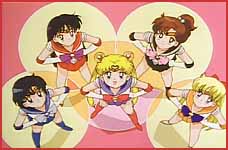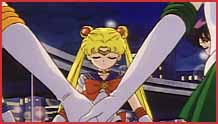by Sandy Yang
|
According to Society for the Promotion of Japanese Animation (SPJA) President Mike Tatsugawa, "Sailor Moon" was indeed primed to be a hit that would also clinch the girls' toy market - an impossible task given Barbie's domination. It didn't. Instead, it broke another seemingly impossible boundary. "I know from talking to the people at (the Japanese toy company) Bandai when 'Sailor Moon' was initially released, the big belief at the toy show was that 'Sailor Moon' would break the Barbie hegemony," Tatsugawa said at Anime Expo 2000. "But when the numbers came in, more boys were watching the show. 'Sailor Moon' would be the ultimate Girl Power show and it was doing well, but in a market no one ever ever predicted." This is also the case for WB's "Card Captors" and Cartoon Network's "Powerpuff Girls," according to Ken Duer, Vice President of Worldwide Production for Warner Bros. "Look at the ratings for 'Card Captors' in the last couple weeks - there are more boys watching than girls," Duer said at the same panel. "Like with 'Sailor Moon,' we have a very strong demographic for boys as well. At the same time, we need more programming geared for girls, but we're finding a mixed message from the audience." Writers and networks say that they aim to attract both boys and girls. However, some feel that US producers are purposely ignoring their female viewers by re-editing and marketing shoujo titles to a male audience. Duer defends that the beginning episodes of many anime titles start out targeted toward one gender, but broaden their demographics with later episodes. He specifically notes that "Card Captors" and "Pokemon," which started out as shoujo and shounen respectively evolved to appeal to all kids. That may explain "Card Captors" (formerly "Card Captor Sakura") eliminating the beginning shoujo parts of the story and airing episodes that also focus on heroine Sakura's boy cousin. Duer said that the network knew the "Card Captor" episodes could attract girls as well as boys given the evenly-split demographics for "Pokemon" and "Sailor Moon."  American niche Marginalized as a solely children's medium, anime struggles to even enter the marketplace. Stigmatized as one geared towards boys at that, shoujo has had a particularly difficult time. Tom Root, staff writer at "Wizard," a comic books guide, says "There isn't a line of comics for girls unless you want to count 'Archie,' but no one really reads 'Archie.'" Writer, artist and editor of several comic books since the 70s Trina Robbins echoes Root's sentiments. "Mainstream comic publishers such as Marvel and DC seem to continue to be clueless about (a female readership) and continue to produce violent superhero comics aimed at guys," says Robbins, who is also a member of Friends of Lulu, a national non-profit organization that promotes and encourages female readership and participation in the comic book industry. She points to shoujo as filling the void of women's comics in America, inspiring more than just female comic book fans but female comic book artists. "You will find shoujo manga-inspired and influenced comics produced - many of them by young women - by the smaller, black and white press," Robbins says. And though much of shoujo, though, appeals to a wide audience. In the United States, animation geared to anyone but children is still risky. Over the past few years primetime animation has made a comeback. Fatalities still run high for adult animation though, like ABC's "Clerks," NBC's "God, the Devil and Bob" and WB's anime influenced "Invasion America," which all got axed before viewers even knew their timeslots. It's a different story in Japan. Comic books and animation are as mainstream as the newspapers and prime-time sitcoms are here, with manga taking up 40% of all publications. The evolution of comic books in Japan has spawned many genres and subgenres including shoujo, which has been in existence since the late 1950s with "Knight of the Ribbon" by Osameu Tezuka (of "Astro Boy" fame). Related genres include josei (women's comics), bishoujo (comics featuring young girls), bishounen (comics featuring young boys) and yaoi/yuri (comics with homosexual themes). So while "Sailor Moon" was popular in Japan, it was hardly ground-breaking. And Flanagan says it was by no means the first Japanese work to feature strong female characters. While "Sailor Moon" (originally titled "Bishoujo Senshi Sailor Moon" - Pretty Soldier Sailor Moon) by female manga artist Naoko Takeuchi debuted in Japan in 1992, classic shoujo stories have long depicted female characters as capable and intelligent people. In one extreme case, 1972's "Rose of Versailles" features a woman who is raised as a male and becomes a captain in the French army. However, shoujo also had its share of lovelorn heroines pining for the perfect guy. Today, shoujo stories feature all types of heroines - not just strong females, but well-rounded characters with myriad personalities. Given the length of some of the shoujo series like "Fushigi Yugi," (56 episodes) "Marmalade Boy" (72 episodes) and "Vision of Escaflowne," (26 episodes) the characters have time to evolve and grow. "I think a lot of my heroines are found in overwhelming circumstances," said Yuu Watase, creator of several ultra-popular shoujo titles, at this year's Anime Expo. "For Miaka in 'Fushigi Yugi' and Aya in 'Ayashi no Ceres,' at the end of the story, they have become more mature women who have found love and they're a little more adult." Even if Japan seems to have an exhaustive variety of comic books and fans, the struggle to create more substantial shoujo heroines continues. "It seemed to me that all the main characters in shoujo manga were batting their eyelashes waiting for their gorgeous prince to take them away, but now shoujo manga has changed," said Chiho Saito at this year's Anime Expo, whose shoujo "Revolutionary Girl Utena" will be published by VIZ this December. "Utena ... breaks the framework of what shoujo manga is. The first thing about Utena is that her main focus is not to be a woman or a girl, but a human being." On the other side of the world, American cartoons may just begin that journey. Though perennially upbeat Sailor Moon heroine Serena (Usagi) seems silly compared to boundary-pushing shoujo heroines [like Utena], the characters in "Sailor Moon" do offer something refreshing to American audiences, Flanagan says. "In the U.S., it's pretty obvious that American animation companies and programmers felt that the only thing that would appeal to girls are cute, fluffy ponies and Barbie," Flanagan says. "I've never seen anything approaching reality directed at girls on U.S. children's TV. That's not to say that I think magically transforming girl superheroes are realistic, but the problems, hopes and other daily events that the girls encounter when they're not battling villains are realistic. Who can empathize with Barbie? But nearly everyone can empathize with Serena (Usagi) when she stumbles over herself." In five years time, "Sailor Moon" has indeed had an impressive run and influence on girls' animation and stories in general. The ephemeral nature of "trend" hasn't yet posed a threat to its burgeoning popularity. Thus far, mainstream shoujo like Sailor Moon has continued to direct fans' interest towards other types of shoujo. "I've always credited 'Sailor Moon' with 'Fushigi Yugi's' success because the audience that started with 'Sailor Moon' is the same one that is now picking up FY, which is aimed at a slightly older demographic," Flanagan says. "There's no doubt that 'Sailor Moon' started all that."
Sailor Moon R © Pioneer Ent.
|

